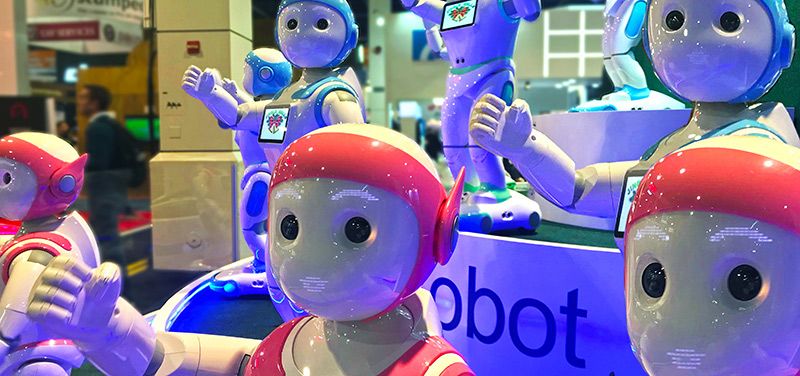It’s more than just a robot
The robotics quarter in the Las Vegas Convention Center breamed with bots rolling about, singing, building, and playing some casual (competitive looking enough for amateurs) ping pong.
A common sight this year were robots geared toward educating the future. Two companies, Abilix and Ovo Technology, both sported spherical white bots that seemed to emulate the character Baymax from the children’s film “Big Hero 6.” Abilix’s Oculus 6, with its wide eyes, pink collar, and porcelain colored shell was both more affectionate and advanced than some of the other models that clunked about.
Across from Oculus 6, Jake Mendelssohn could be found excitedly chatting to visitors about his robotics passion. A teacher and member of the Connecticut Robot Society, Mendelssohn has for years tagged along with Abilix, whose bots focus on voice interactions to provide stimulating experiences. To him, robotics has become more than just the physical objects that are programed to operate independently. They have become beings that flourish off human interaction.
“The robot just sits there, you add the human intelligence to it and that makes it functional…somewhere here on one of the signs, it says that the robot has to be intelligent, but the robot doesn't have to be able to do anything by itself,” said Mendelssohn. “It's the human being that teaches the robot how to solve the problem, and in teaching the robot they learn how to solve it themselves. And that's really the educational value of robotics."
The little round Oculus 6 bot combines two important factors in customer experience. First it has the obvious visual appeal to pull users in, similar to the robot design method of “Moe,” (Massiveness, coolness, and roundness) mentioned by Naoto Hayashi and Masashi Yamada in their study on robotics. It’s a reminder that no matter how neat the material is on the inside, a product needs to look the part for its audience. In this case, Oculus 6 is a “cute” companion that serves as an educational tool.
But perhaps more importantly, as Mendelssohn said, robots rely on human interaction to achieve their goal. As with any good teacher, the robots at CES live to interact with its peers. Combining emotions and technology provides that customer experience where the interactions take you through a journey with someone else, even if that someone runs on batteries.
Creating a new CX reality
The virtual reality game ROTU, Rhythm of the Universe, was walled off with a single entrance opening to another world. The objective is to totally immerse the player in something completely new, and it all begins in darkness. First, the helmet and earbuds block off the player’s senses, leaving the player standing in a black void while observers only imagine what they’re seeing.
Then there’s light. The user drops into the ruins of an alien jungle world, the headset buzzes with ominous noise, and as the player’s hands come up, he or she sees a change. Two controllers, one for each hand, transform into gnarled fists wrapped in dirty rags. Users experience life as someone else. A character’s voice guides the user through the new environment, placing tablets into mechanisms, playing instruments to unlock puzzles, and even feeding an ailing beast.
The charm of a virtual reality is the hyper-personalized and individual experience the user gets from the journey. When someone is left to their own devices with a product, any roadblocks or mistakes that create friction are extremely noticeable, particularly when they’re transported into the game itself. With VR it’s the experience, and there’s no better experience than being immersed in a product. As stated in Forbes, about 40 percent of U.S. consumers will spend more money because of personalized service. While another 40 percent would shop the same brand after a personalized experience. The user gameplay needs to seamless and without outside interference. It’s personal as it gets.
Back to the IoT drawing board
CES 2018 thrived on connectivity (even when the power briefly disconnected on Wednesday), bots, drones, and appliances all fed off tablets, phones, and wireless connections in an IoT ecosystem.
Chris Murray, director of industrial design at Bresslergroup, hosted “It’s Not the Technology, it’s the Experience” to discuss how connected devices can reinvent or destroy a customer experience. Bresslergroup, a tech design firm, implements connected designs into anything from sprinklers that can read off the weather to football helmets that remotely inflate its impact cushions precisely.
A signature touch for many of its products are vibrantly colored lights that create visual touchpoints in the customer journey. For example, its work with BD Totalys clinical diagnostic instruments glow in different colors to give busy doctors a heads up, in addition to indicating the urgency to reach the machine.
“We believe that design research at the front end builds that foundation for creating successful brand experience touchpoints throughout the whole experience,” said Murray. “And that goes from initial awareness in the product, through to purchase, unboxing, onboarding, and learning how to use it through successful repeated use. And eventually you get that loyalty in a brand by creating these distinctive interaction and experience touchpoints."
Yet for all the advances made over the years, Murray wanted to touch on two CX standards that often get lost in IoT:
-
Keep it simple: Allow the interaction to stay in the device its intended for. If a user is setting up a sprinkler intended to be used through an app, make sure they don’t have to use a PC to find additional features or support. In addition, give the user ample time to get used to and configure the connected device.
"No consumer wants to feel rushed during that initial experience of provisioning a new device on their network,” said Murray. “This can lead to frustration and the consumer eventually giving up on the product before they got it actually connected.”
- Ensure the experience stays easy: This means understanding the product’s digital and physical relationship. Its HelmetFit product remotely inflates helmet padding and needs to rely on seamless interactions between the user and the tech. The onboarding process must ensure that the user understands how to physically control the pump and use the phone interface. A vital part of this was creating a workflow map that spotted out friction in both digital and physical, he explained
Scrabble and the human connection
The day concluded with an ITRI robot playing multiple Scrabble games. After the dust settled, the tall green and white robot’s record was 100-50, twice as successful as its human competitor. But it was an important reminder of Mendelssohn’s view on tech’s place in the world. Without that human interaction it doesn’t serve a purpose. The customer’s journey with the robot takes just as much effort from themselves to complete. CES 2018 served as important reminder that innovators need to keep in mind that the customer’s experience still means everything in a growing tech world.







